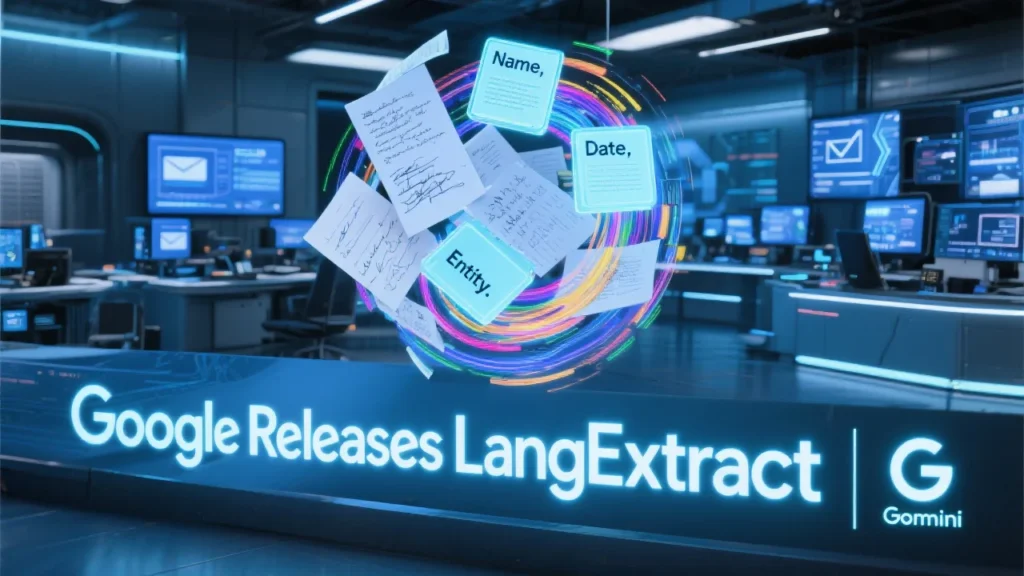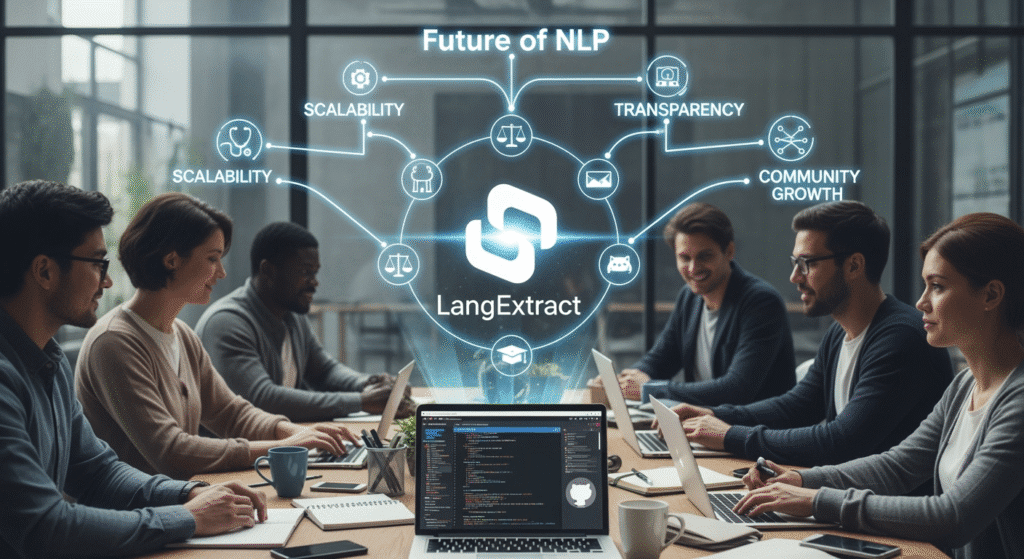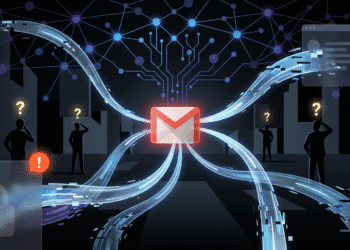Google has just dropped a game-changer in the world of natural language processing. Meet LangExtract, an open-source Python library that’s about to transform how we extract structured data from messy, unstructured text documents.
Released on July 30, 2025, this Gemini-powered tool tackles one of the biggest headaches in data science. You know the drill valuable insights buried deep in clinical notes, legal contracts, customer feedback, and research papers. LangExtract promises to unlock that data with precision and traceability.

What Makes LangExtract Different?
Traditional NLP tools often feel like using a sledgehammer to crack a nut. They demand extensive fine-tuning, massive datasets, and serious computational muscle. LangExtract flips this script entirely.
The library leverages large language models like Google’s Gemini family to process unstructured text into structured information. But here’s the kicker it does this with just a few well-crafted examples and prompts. No more wrestling with complex training pipelines or burning through compute resources.
The Power of Few-Shot Learning
LangExtract’s secret sauce lies in its few-shot learning approach. You provide the system with a handful of high-quality examples, and it learns your desired output format. This eliminates the traditional need for extensive data labeling and model fine-tuning.
The process is surprisingly straightforward. Define your extraction task using natural language instructions. Provide a few examples of what you want extracted. Let LangExtract handle the rest.
Precise Source Grounding Changes Everything
Here’s where things get really interesting. Every piece of information LangExtract extracts gets mapped back to its exact character offsets in the source text. This isn’t just a nice-to-have feature it’s revolutionary for verification and auditing.
Imagine processing thousands of medical reports and being able to trace every extracted medication dosage back to the exact sentence where it appeared. That’s the level of precision we’re talking about.
Long-Context Processing That Actually Works
Large documents have always been a nightmare for NLP systems. The infamous “needle-in-a-haystack” problem where important information gets lost in massive contexts. LangExtract tackles this head-on with intelligent chunking strategies, parallel processing, and multiple extraction passes.
The system can handle entire novels Google demonstrated this with a complete analysis of Romeo and Juliet. It maintains contextual accuracy while processing documents that would overwhelm traditional approaches.
Interactive Visualization Brings Data to Life
Raw extraction results are useful, but LangExtract takes it further. The library generates interactive HTML visualizations that let you explore extracted entities in their original context. Hover over highlighted text to see extraction details. Navigate through thousands of annotations with ease.
This visualization capability transforms how teams review and validate extraction results. No more squinting at JSON files or cross-referencing spreadsheets. Everything’s visual, interactive, and immediately understandable.
Real-World Applications Across Industries
LangExtract isn’t just another research project. It’s built for real-world applications across multiple industries.
Healthcare leads the charge with medication extraction from clinical notes. The system can identify drugs, dosages, administration schedules, and patient responses all traced back to source documentation. Google even developed RadExtract, a specialized demo for structuring radiology reports.
Legal and financial services benefit from automated contract analysis and risk assessment. Extract key clauses, terms, and obligations from dense legal documents with full source traceability.
Research and academia can process vast literature collections, extracting methodologies, findings, and citations at scale. The system handles everything from scientific papers to historical documents.
Getting Started Is Surprisingly Simple
Installation takes seconds with a simple pip command:
pip install langextract
The learning curve is gentle. Here’s how you’d extract character information from Shakespeare:
import langextract as lx
import textwrap
# Define your extraction prompt
prompt = textwrap.dedent("""
Extract characters, emotions, and relationships in order of appearance.
Use exact text for extractions. Do not paraphrase or overlap entities.
Provide meaningful attributes for each entity to add context.
""")
# Provide a high-quality example
examples = [
lx.data.ExampleData(
text="ROMEO. But soft! What light through yonder window breaks? It is the east, and Juliet is the sun.",
extractions=[
lx.data.Extraction(extraction_class="character", extraction_text="ROMEO", attributes={"emotional_state": "wonder"}),
lx.data.Extraction(extraction_class="emotion", extraction_text="But soft!", attributes={"feeling": "gentle awe"}),
lx.data.Extraction(extraction_class="relationship", extraction_text="Juliet is the sun", attributes={"type": "metaphor"}),
],
)
]
# Run extraction on new text
result = lx.extract(
text_or_documents="Lady Juliet gazed longingly at the stars, her heart aching for Romeo",
prompt_description=prompt,
examples=examples,
model_id="gemini-2.5-pro"
)
Flexible Model Support
While LangExtract showcases Google’s Gemini models, it’s not locked into a single ecosystem. The library supports various LLM backends, including cloud-based services and open-source models running locally.
This flexibility means you can balance performance, cost, and privacy requirements. Start with powerful cloud models for development, then potentially move to local deployment for production.
Schema Enforcement Eliminates Guesswork
One of LangExtract’s standout features is reliable structured output generation. Define your desired schema using the library’s data representation, and it enforces consistency across extractions.
For supported models like Gemini, LangExtract uses controlled generation to guarantee JSON outputs that match your specifications. No more parsing inconsistent responses or handling schema drift.
Comparing Traditional Approaches
Traditional NLP tools like BERT-based systems require substantial fine-tuning and computational resources. They often struggle with domain adaptation and need extensive labeled datasets.
LangExtract eliminates much of this complexity. The few-shot learning approach means you can tackle new domains with minimal examples. The operational efficiency comes from using LLMs as a service, reducing infrastructure overhead.
Tools like Prodigy and SpaCy have their place, but LangExtract offers a more user-centric design focused on simplicity and scalability.
Performance and Scalability
Early reports suggest LangExtract delivers impressive performance across various domains. The parallel processing capabilities handle large document collections efficiently. The chunking strategy maintains accuracy even with million-token contexts.
The system’s ability to process long documents while preserving contextual relationships sets it apart from traditional windowing approaches that often lose important connections.
Industry Impact and Future Implications
LangExtract represents a significant step toward democratizing advanced NLP capabilities. The low barrier to entry means smaller organizations can leverage sophisticated text processing without massive infrastructure investments.
The emphasis on verifiability and source grounding addresses critical concerns in regulated industries. Healthcare, finance, and legal sectors need audit trails and explainable AI-LangExtract delivers both.
Open Source Advantage
Google’s decision to release LangExtract as open source accelerates innovation across the ecosystem. Developers can extend the library, contribute improvements, and adapt it for specialized use cases.
The GitHub repository provides comprehensive documentation, examples, and community support. This collaborative approach ensures the tool evolves with user needs.
Looking Ahead
LangExtract arrives at a perfect time. Organizations are drowning in unstructured data while demanding more transparency from AI systems. The combination of powerful extraction capabilities with full source traceability addresses both challenges.
The library’s success will likely inspire similar approaches across the industry. We’re seeing a shift toward more interpretable, verifiable AI systems LangExtract leads this charge.
As LLMs continue improving, tools like LangExtract will become even more powerful. The few-shot learning approach scales naturally with model capabilities, promising even better results with future iterations.
Getting Involved

The LangExtract community is just getting started. Developers can contribute to the project, share use cases, and help shape the library’s evolution. The combination of Google’s backing and open-source development creates exciting possibilities.
For organizations considering adoption, the low-risk entry point makes experimentation easy. Start with a small pilot project, explore the capabilities, and scale based on results.
LangExtract isn’t just another NLP library it’s a glimpse into the future of intelligent document processing. The combination of power, simplicity, and verifiability sets a new standard for the industry.
Sources
- Introducing LangExtract: A Gemini powered information extraction library – Google Developers Blog
- Google AI Releases LangExtract: An Open Source Python Library that Extracts Structured Data from Unstructured Text Documents – MarkTechPost
- LangExtract: Google’s New Library for Simplifying Language Processing Tasks (NLP) – Geeky Gadgets
- LangExtract GitHub Repository










Comments 1